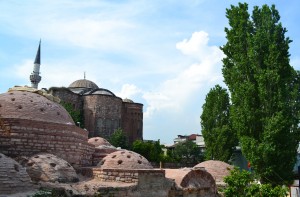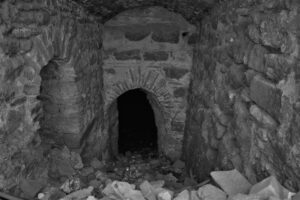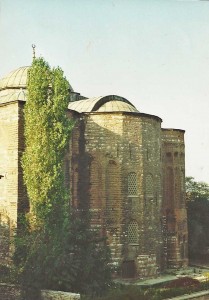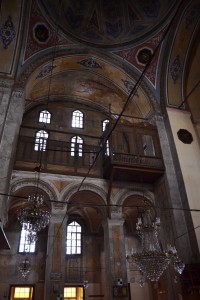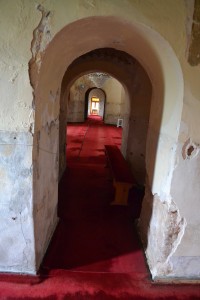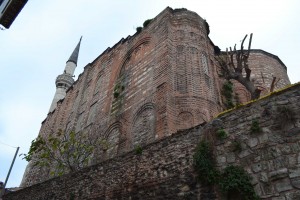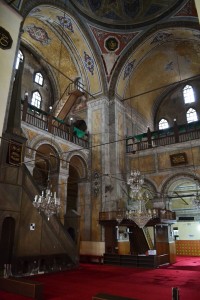This fortress of a church is visible for miles around but it tends to be a bit tricky to find in the labyrinth of streets around the new Kadir Has University 41.026912,28.956147). The church looks as if it has been built on stilts. The massive crypt would be a tremendous location for filming a horror movie.
The inner door is locked when not in use so go in at prayer time. Nobody seems to mind if you’re respectful. The restoration of the nearby hamam complex will make this a picturesque neighbourhood.
This is a cross-in-square church from the late 11th/early 12th century with a lot of Ottoman repair and restoration. As usual, the original dedication is lost but reasonable guesses lead to its identification with the Church of St Theodosia. Theodosia was an iconodule heroine who attained her fame at the start of iconclast rule by shaking a ladder that a soldier was using to remove an image of Christ from the Chalke Gate. He died. Theodosia was executed and, with the defeat of iconoclasm became a saint and a retrospective virgin. The present Gül Camii may be the church in which her relics were kept.
There are several other candidates for the dedication of the church but the travelling German scholar-priest Stephan Gerlach decided in the 16th century that this was the Church of St Theodosia. The origin of the current name of Gül Camii (Rose Mosque) stems from the story that at the time of the Ottoman Conquest in 1453, the church was decorated with flowers for the feast of St Theodosia. The Emperor and Patriarch had just conducted the last mass and high-ranking ladies had gathered to pray for a different outcome to the day’s events. When the Sultan’s soldiers entered the church, they were greeted with the sight of roses. It was not until 1490 that the building was renovated and reopened as a mosque but story is that it was named Gül Camii because of those flowers. On the other hand, it seems that an Ottoman holy man named Gül Baba is buried in the building. This may be the slightly less romantic origin of the name.
The two outer apses on the south-eastern face are probably original. They look very much like similar features on the south church of Zeyrek Camii (now plastered over), built at about the same time. The central apse looks very different and probably stems from a restoration in the early 17th century following an earthquake. The dome is probably from this time, replacing a higher one that had been mounted on a drum.
In late January, 2015, there was some laser positioning work going on in preparation for a putative restoration. The painting in the interior comes from the 18th century and shows significant damage from damp. In January 2016, the place looked in need of some attention to stop the plaster from falling on the heads of the worshippers.
Foundation of the Hellenic World. (2008) Theodosia (Gül Camii) Encyclopaedia of the Hellenic World. Available online at: http://constantinople.ehw.gr/Forms/fLemmaBody.aspx?lemmaid=11775#noteendNote_2 Accessed 14th April 2016
Müller-Wiener, W., Bildlexikon zur Topographie Istanbuls, Byzantion – Konstantinupolis – Istanbul (Tübingen 1977), pp. 141-143.
van Millingen, A. (1912) Byzantine Churches in Constantinople: Their History and Architecture. Macmillan, London. pp164 - 182
Available online at: https://www.gutenberg.org/files/29077/29077-h/29077-h.htm
Accessed 14th April 2016

Categories: Uncategorized | No Comments »
